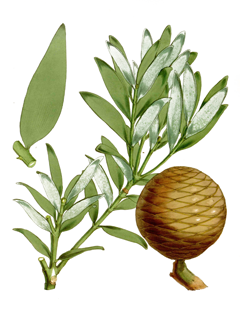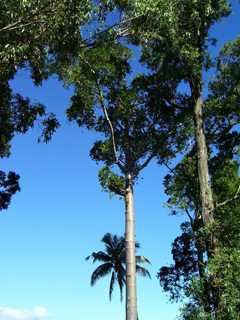 |
|
http://www.edibleplants.org/ |
 |
| wikimedia.org User:Tau?olunga |
Translate this page:
Summary
Agathis macrophylla, Dakua or Pacific kauri is a fast growing large tropical tree. It grows 40 m high with a trunk to 3 m across. An excellent commercial timber.
Physical Characteristics

 Agathis macrophylla is an evergreen Tree growing to 30 m (98ft) by 8 m (26ft) at a fast rate.
Agathis macrophylla is an evergreen Tree growing to 30 m (98ft) by 8 m (26ft) at a fast rate.
See above for USDA hardiness. It is hardy to UK zone 10 and is frost tender. The flowers are pollinated by Wind.
Suitable for: light (sandy), medium (loamy) and heavy (clay) soils, prefers well-drained soil and can grow in nutritionally poor soil. Suitable pH: mildly acid, neutral and basic (mildly alkaline) soils and can grow in very acid, very alkaline and saline soils.
It can grow in full shade (deep woodland) semi-shade (light woodland) or no shade. It prefers moist soil. The plant can tolerate maritime exposure.
UK Hardiness Map
US Hardiness Map
Synonyms
Abies dammara (Lamb.) Poir. Agathis alba (Rumph. ex Hassk.) Foxw. Agathis celebica (Koord.) Warb. Ag
Plant Habitats
Edible Uses
References More on Edible Uses
Medicinal Uses
Plants For A Future can not take any responsibility for any adverse effects from the use of plants. Always seek advice from a professional before using a plant medicinally.
None Known
References More on Medicinal Uses
The Bookshop: Edible Plant Books
Our Latest books on Perennial Plants For Food Forests and Permaculture Gardens in paperback or digital formats.

Edible Tropical Plants
Food Forest Plants for Hotter Conditions: 250+ Plants For Tropical Food Forests & Permaculture Gardens.
More

Edible Temperate Plants
Plants for Your Food Forest: 500 Plants for Temperate Food Forests & Permaculture Gardens.
More

More Books
PFAF have eight books available in paperback and digital formats. Browse the shop for more information.
Shop Now
Other Uses
Dye Hair Lighting Resin Shelterbelt Soil stabilization Wood
Agroforestry Uses: Tropical cyclones occur at periodic intervals in all parts of its range. Pacific kauri has an ability to withstand strong winds thereby acting as a wind break or barrier. In certain situations it is suited as boundary marker, due to size and longevity[ 303 ]. The species is suitable for soil protection and binding in areas where long term stabilization of less stable soil profiles is needed. It has spreading root systems that help stabilize soils on ridges and slopes[ 303 ]. The tree is mainly suitable as a long term top storey tree for more shade tolerant understory crops; however, wide-spaced plantings of less dense forms may provide light shade for a wider variety of crops[ 303 ]. Other Uses A resin, called 'resin of Fiji', is obtained from the trunk[ 46 ]. The resin, produced from the living inner bark, was an important component of many varnishes and is still used mixed with synthetics. Commercial export of the resin was formerly practiced in Fiji but was prohibited in 1941, as no method could be found for tapping an economic yield of gum without endangering the life of the tree[ 312 ]. The resin is traditionally used as canoe caulk, and the resin soot was used for tattoos[ 312 ]. The resin has also been used for glazing pots[ 312 ]. The resin has also been used for lighting and torches[ 312 ]. Smoke residues of the burnt resin were traditionally used as a dye for the hair[ 303 ]. The heartwood is pale cream to gold brown; the sapwood straw yellow to pale brown. The wood is finely grained, lustrous, uniform and easily worked. Damage from pinhole borers may occur in standing trees, while drywood termites and Anobium borers may cause damage in service. The wood is readily kiln dried with a medium shrinkage value. In service the timber is very stable. It is suitable for a wide range of end-uses including laboratory bench tops, vats, sauna baths, battery separators, weatherboards, bowls, novelties, handles, furniture, veneer, and boat building[ 303 , 312 ]. It has good peeling and gluing properties and is highly sought after for surface veneer[ 312 ]. Its finely grained, pale, easily worked, and uniform timber is of major commercial importance with various high value end-uses, including furniture, handicrafts, veneer, boat building, light construction, and panelling[ 312 ].
Special Uses
Food Forest
References More on Other Uses
Cultivation details
A plant of the moister lowland tropics and subtropics, growing in areas where the rainfall is evenly distributed throughout the year and is in the range of 1,900 - 6,000 mm[ 312 ]. The mean annual temperature is in the range 25 - 28°c[ 312 ] Most commonly found on well structured, friable, and freely drained soils[ 312 ]. Prefers a position in full sun or light shade[ 312 ], it can also tolerate quite considerable shade, though growth will be greatly reduced[ 303 ]. Young plants require sheltered, shady positions. The tree generally prefers basalt-derived clay loams and clays with a well developed upper humus layer. It has also been reported on coral limestone terraces and bordering mangrove vegetation[ 312 ]. Tree growth is poor on compacted and waterlogged soils[ 312 ]. Plants can withstand strong winds[ 312 ]. Grows well in acid soils, tolerating a pH in the range 4.0 - 7.4[ 312 ]. A long lived tree that can live for up to 1,000 years[ 312 ]. It is fairly fast-growing tree, in favourable conditions, annual growth can reach about 1 - 1.5 metres[ 312 ]. Young specimens have a vigorous taproot, whilst mature specimens have wide, spreading root systems that help stabilize soils on ridges and slopes[ 312 ]. Trees start producing flowers when about 10 years old, the seed taking two years to mature[ 312 ]. The use of selected, superior seed provenances (notably from Vanuatu) and good silviculture will enable the commercial production of timber and veneer in plantations on a 40 - 55-year rotation period[ 312 ]. For introduction into areas outside of its natural range, it is important to inoculate seedlings with appropriate mycorrhizal fungi[ 303 ]. From a plantation viewpoint, this species stands apart from most other members of the genus because of its ability to grow moderately fast and establish in open, sunny sites[ 312 ].
References Carbon Farming Information and Carbon Sequestration Information
Temperature Converter
Type a value in the Celsius field to convert the value to Fahrenheit:
Fahrenheit:
The PFAF Bookshop
Plants For A Future have a number of books available in paperback and digital form. Book titles include Edible Plants, Edible Perennials, Edible Trees,Edible Shrubs, Woodland Gardening, and Temperate Food Forest Plants. Our new book is Food Forest Plants For Hotter Conditions (Tropical and Sub-Tropical).
Shop Now
Plant Propagation
Seed - no pre-treatment is required, and fresh, undamaged seeds germinate rapidly, commencing within 2 - 7 days (at 26°c and completed by 14 days[ 312 ]. Sow in containers in light shade[ 312 ]. Plant out seedlings after about 6 - 12 months when they are about 30cm tall[ 303 , 312 ]. Cuttings of leading shoots[ 307 ].
Other Names
If available other names are mentioned here
Also known as: Duro, Hoe, Makadre, Marabete, Nejev, Nendu, Takua.
Native Plant Search
Search over 900 plants ideal for food forests and permaculture gardens. Filter to search native plants to your area. The plants selected are the plants in our book 'Plants For Your Food Forest: 500 Plants for Temperate Food Forests and Permaculture Gardens, as well as plants chosen for our forthcoming related books for Tropical/Hot Wet Climates and Mediterranean/Hot Dry Climates. Native Plant Search
Found In
Countries where the plant has been found are listed here if the information is available
Found In: Australia, New Caledonia, Pacific, Papua New Guinea, PNG, Solomon Islands, Vanuatu.
Weed Potential
Right plant wrong place. We are currently updating this section.
Please note that a plant may be invasive in one area but may not in your area so it’s worth checking.
Conservation Status
IUCN Red List of Threatened Plants Status : Agathis macrophylla (Fijian Kauri Pine): Status: Endangered B2ab(i,ii,iii,iv,v) ver 3.1
Pop. trend: decreasing

Growth: S = slow M = medium F = fast. Soil: L = light (sandy) M = medium H = heavy (clay). pH: A = acid N = neutral B = basic (alkaline). Shade: F = full shade S = semi-shade N = no shade. Moisture: D = dry M = Moist We = wet Wa = water.

Expert comment
Author
(Lindl.) Mast.
Botanical References
303312
Links / References
For a list of references used on this page please go here
Readers comment
| Add a comment |
|
If you have important information about this plant that may help other users please add a comment or link below. Only comments or links that are felt to be directly relevant to a plant will be included. If you think a comment/link or information contained on this page is inaccurate or misleading we would welcome your feedback at [email protected]. If you have questions about a plant please use the Forum on this website as we do not have the resources to answer questions ourselves.
* Please note: the comments by website users are not necessarily those held by PFAF and may give misleading or inaccurate information.
To leave a comment please Register or login here All comments need to be approved so will not appear immediately.
|
Subject : Agathis macrophylla
|
|
|
|